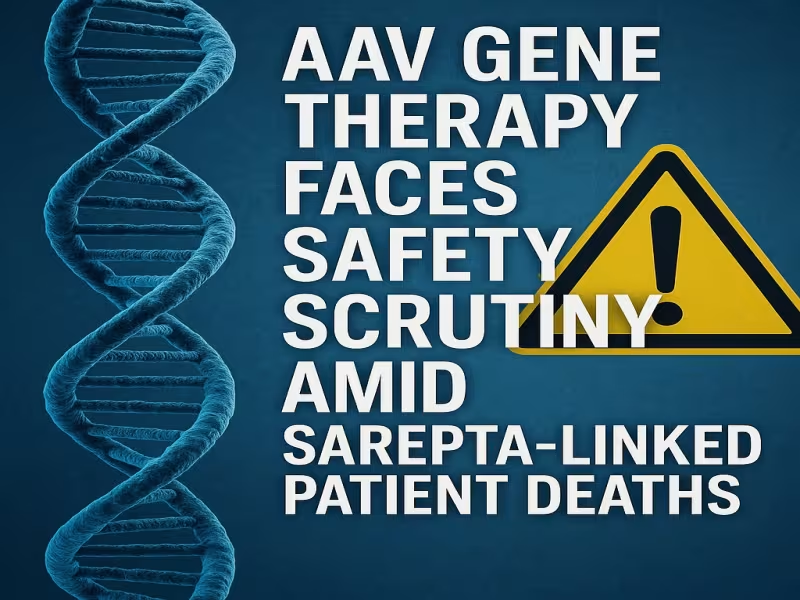
SHERIDAN, WYOMING – August 12, 2025 – A wave of safety concerns surrounding adeno-associated virus (AAV) gene therapy has hit the biotechnology sector following multiple patient deaths linked to Sarepta Therapeutics’ platform. While some stakeholders push for urgent refinements to the decades-old technology, others are accelerating work on alternative delivery systems that could reshape the future of genetic medicine.
Safety Concerns Emerge in Duchenne and Other Programs
Sarepta’s Elevidys, an AAV-based therapy for Duchenne muscular dystrophy (DMD), is under intense scrutiny after two DMD patients and one limb-girdle muscular dystrophy trial participant died from liver injuries. All three cases were tied to the same AAV platform, raising concerns about the vector’s immunogenicity and its tendency to accumulate in the liver.
Experts note that while liver accumulation is common for intravenously delivered drugs, viral vectors pose higher risks of immune system overactivation, potentially triggering severe reactions such as cytokine storms.
Why DMD Treatments Carry Higher Dosing Risks
DMD’s genetic defect occurs in muscle tissue, a challenging target for AAVs. Because muscle is dispersed throughout the body, delivery requires significantly higher systemic doses than liver-targeted conditions. These elevated doses increase viral load, compounding the risk of liver toxicity.
Manufacturing inefficiencies also play a role: up to 50% of AAV capsids may be empty, effectively doubling the viral exposure without delivering additional therapeutic benefit.
Industry Responses: Dose Optimization and Immune Modulation
In response, biopharma companies and academic labs are investing in improved purification methods, including ultracentrifugation and advanced chromatography, to reduce empty capsids and lower effective dosing.
Some developers are pairing AAV therapies with steroids to blunt immune responses — a strategy already used in programs such as Ultragenyx’s Sanfilippo syndrome candidate. While the FDA recently issued a Complete Response Letter for UX111 over manufacturing concerns, Ultragenyx leadership remains confident in AAV’s long-term role.
Market Outlook: Adapt or Diversify?
Despite public fears, AAV remains attractive due to its ability to deliver DNA to the nucleus of non-dividing cells, a capability unmatched by retroviruses or lentiviruses. Analysts believe the platform is unlikely to disappear but will require next-generation engineering to address immunogenicity and targeting limitations.
Several biotechs, including Solid Bioscience, are exploring novel capsid designs to expand tissue tropism and reduce liver burden, potentially unlocking safer systemic delivery.
Alternatives Gain Ground: The Rise of Lipid Nanoparticles
Meanwhile, lipid nanoparticle (LNP) platforms are gaining traction as a non-viral alternative, offering lower immune activation risks. Already proven in mRNA vaccines like Moderna’s Spikevax and RNAi drugs such as Alnylam’s Onpattro, LNPs show promise for liver-directed therapies. However, like AAVs, they face targeting challenges for non-liver tissues — a key barrier for neuromuscular indications like DMD.
Strategic Implications for Gene Therapy Stakeholders
For hospitals, contract manufacturers, and gene therapy developers, the unfolding AAV debate underscores the need for:
- Enhanced vector quality control to minimize empty capsids
- Dosing strategies that balance efficacy and safety
- Expanded platform portfolios to mitigate single-technology risk
- Collaborative regulatory engagement to align safety benchmarks
Industry leaders stress that while technology innovation is essential, patient timelines remain critical. As Ultragenyx CEO Emil Kakkis stated, “There are kids living and dying today, so it’s now or never, not three to five years from now on. In that setting, the treatment has value.”
Learn more about advancements in vector engineering and gene therapy delivery systems at fairsonline.org.